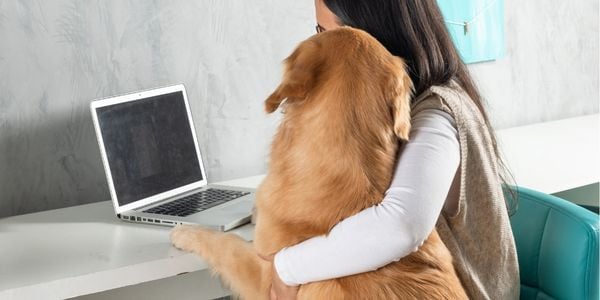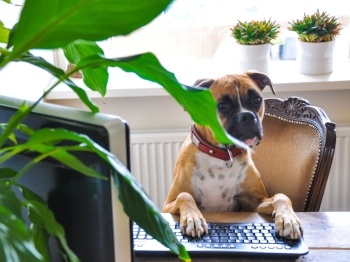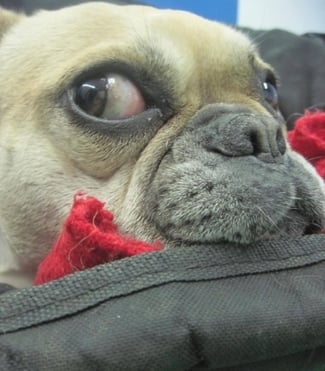
Many companies now allow their employees to bring dogs to work, and more workplaces are doing the same. According to the 2015 Society for Human Resource Management survey, 8 percent of American workplaces allowed employees to bring pets to work, which was up from 5 percent that had such a policy two years earlier.
Amazon, for example, has not only opened its own downtown dog park but “more than 2,000 dogs are brought in regularly to Amazon's main campus where about 25,000 employees work,” according to CNBC.
You could even say that modern workplaces have really... gone to the dogs (cue rimshot).
As fun as it can be to take your pooch to work, it’s easy for that experience to tip from fun to stressful — for both of you. Many offices are fast learning that it’s important to set some ground rules before allowing dogs to come to work. The Society for Human Resource Management, recommends following a pet-friendly office checklist .
While these tips are great for the business, what about you and your dog? After all, just because your office has a pet-friendly policy, it doesn’t mean you’re both ready to work together. Even if you think your office is relatively boring, it can still be stimulating — maybe even overwhelming — for your dog.
Here are some tips to get you and your pup ready for the 9–5 grind.
Make Your Workplace Comfortable for Your Dog
Just like you might bring in pictures and personal effects to spruce up your workspace, you can gather a few items that will help your dog feel more at home, too.
Bring in a comfy dog bed so they can zonk out while you finish that big project. Gather up toys and a few of their favorite items that smell like home. And, of course, bring lots of treats to reward their good behaviors, which could be as simple as sitting quietly by your side.
How to Train Your Dog to Behave at Work
Regardless of where you work and whether it’s a dog-friendly office, it’s safe to say that one or all of these behaviors from your dog will get you in trouble.
- Barking
- Running wildly through the building
- Garbage surfing
- Accosting people with unwanted sniffing and, perhaps, jumping
The following is an abbreviated version of training these cues. To learn more about dog training, check out our library of articles and videos.
Sit
- Stand near your dog with a treat in one hand and a clicker in the other, wait for them to sit.
- When they sit, click, toss them a treat, and offer praise.
- Toss the treat just far enough away that they have to stand to get it.
- Wait for them to sit again and repeat the treat and praise.
- After they get it (probably a few dozen tries) repeat the training but use a hand signal, then click and treat when they sit.
- Once they’ve nailed the hand signal, add in the word the word “sit.”
- Continue until they sit, on command, consistently.
Read more tips and how-to's in our article "2 Easy Ways to Teach Your Dog to Sit."
Stay
- Have your dog sit and hold your arm out, palm facing toward them.
- Step back, wait a moment, then return, touch their collar, and reward with a treat (repeat a few times).
- Continue the same routine, but add in the word “stay.”
- Move farther and farther away, or stay away longer before giving your dog a treat for a successful stay.
- Add in distractions such as toys, moving around, or actually leaving the room.
Want a step-by-step guide to train your dog to stay? Check out our article "How to Teach Your Dog to Stay."
Barking
This can be a complicated behavior to discourage or correct. Your best bet to reduce barking is to ignore it as much as possible. By engaging your dog in any way when they bark, you are helping to reinforce the behavior. When it comes to dissuading unwanted behaviors like barking, remember that the goal is to reward the good behavior, not punish the bad. Encourage your dog when they’re behaving the way you like, and ignore them when they’re acting less than professional.
Of course, it’s hard to ignore a barking dog at work, so start encouraging good behaviors at home — and be consistent. For more information, check out this great overview on getting your dog to stop barking in our article "Why Your Dog is Barking and How to Stop It."
Things at Work That Are Dangerous to Dogs
You only need to read the headline “Dog Doing ‘Amazingly’ Well After Losing Tongue in Paper Shredder” to realize that a seemingly innocuous office appliance can become a significant hazard for your dog when you bring them to work.
Long story short: keep paper shredders unplugged or in the “off” position (never “standby” or “automatic”) to keep your dog safe. In our book, 101 Essential Tips, we outline the hazard of paper shredders, among other (even more common) hazards in your dog’s environment.
Paper shredders are one of the most serious threats to your dog at work — with tails, ears, and even tongues prone to getting caught by the blades — but there are other workplace hazards to watch out for:
- Electrical cords: Dogs can sustain burns on their tongues or mouths from chewing on electrical cords. In severe electrical shock cases, they can develop a buildup of fluid in their lungs, seizures, or even heart failure.
- Garbage Cans: Garbage cans are full of tantalizing items to dogs. An easy-to-reach chip bag is both tempting and a severe suffocation hazard. (Cut all bags twice and watch out for snack bags coworkers have left on their desks or in the trash.) Likewise, your dog might go garbage surfing and find everything from onions, garlic, or chives in partially eaten lunch, chocolate, or even xylitol in a piece of discarded chewing gum.
- Purses and other bags: An unguarded purse, backpack, or other bag might contain a number of harmful things that your dog could easily eat. Medications, chocolate, or the more than 700 items that contain deadly xylitol can be easy pickings for your dog at work. Guard your bag and keep an eye out for coworkers’ bags.
- Learn more about pet poison control
How to Socialize Your Dog for Work
Remember how nervous and confused you were on your first day of work? Now imagine that experience if you couldn’t understand anyone, everything smelled weird, it was loud, and someone kept telling you not to do things that always seemed fine at home.
You’re probably excited to bring your dog to work to prove that they are, in fact, the cutest thing ever. But before you get ready for your big show-and-tell day, it’s important to take the proper socialization steps so your dog is ready for whatever the office has to throw at them. Ideally, you should socialize your dog as early as possible (if you have a puppy, the first 3–4 months are prime socialization time, after which it can get more difficult). Depending on your dog’s personality, the age you got them, and other factors, the ideal isn’t always possible. That being said, here are steps you can take to get your dog ready to handle office politics.
- Introduce Your Dog to Coworkers: Take your dog for a quick, leashed walk around the office and introduce them to the people in your area. Offer treats and praise when your dog meets new people (unless they’re jumping or displaying other unwanted behaviors).
- Introduce Your Dog to Coworkers’ Dogs: Go for a walk in neutral territory with other dogs from the office and their people. Walking with other dogs is a great way to make introductions and help new dogs get off on the right paw. Lay it on heavy with the treats for both dogs as you make the introduction, and watch out for signs of stress or aggression. If things are getting too rambunctious or aggressive, just back off for a while.
- Get Your Dog Ready for the Commute: If your dog’s only experience with the car is as a moving prison transport to either the vet or the groomer, they'll enjoy the commute to and from work even less than you do. Take them for a few fun trips in the car, so they don’t always associate travel with fear or anxiety. And make sure you’ve equipped the car with either a good pet travel restraint or their crate/carrier.
Crate Your Dog at Work
You can’t always control your environment when you’re at work. People wander in and out, there are strange noises and smells to deal with, and you probably need to get up once or twice for your own potty break.
Though you can’t control the office environment, you can give your dog a space to call their own. By providing a properly sized crate, you can create a place for your dog where they A) won’t feel threatened and B) can't dart away or go chasing after that generous, but unwitting, coworker who decided to bring donuts to work.
If a crate isn’t an option, try using a baby gate, or other barrier, to separate your workspace from the rest of the office.
To learn more about crate training, check out “Everything You Need to Know About Crate Training Your Puppy or Adult Dog.”
Potty Training Your Dog for Work
The workplace presents a few conundrums when it comes to potty training.
It might go without saying, but make sure your dog has potty training down before you decide to take them to work. It’s one thing for your dog to have an accident at home, but a dookie in the office is even less fun to deal with.
Work on potty training at home before bringing your dog to work, but continue the best practices when you’re at the office.
- Take lots of outdoor bathroom breaks and walks.
- Reward your dog when they go outside, where they’re supposed to.
- Do not punish them or rub their nose in it if there’s an accident, as this can make matters worse.
- Don’t forget to pack poop bags as well as cleaning supplies… just in case.
If your dog does decide to act unprofessionally by soiling your cubicle rug, be sure to clean it thoroughly with an enzymatic cleaner that will eliminate the smell to reduce the chances of a repeat, either by your dog or another dog in the office that catches a whiff (not to mention that hyper-competitive guy from accounting who takes every challenge waaaay too far).
How to Tell If Your Dog Is Stressed at Work
Your dog might not be able to talk, but they are constantly communicating — you just have to know what to look for. Something as simple as a yawn or even tail wagging might be a sign that your dog is not enjoying their time at work.
If you see your dog exhibiting stressful behaviors, give them a break from the office by either taking them home, if possible and depending on their stress level, letting them hide out in their crate to calm down, or no longer bringing them to work while you continue socialization and training in a more controlled environment.
Also, consider that many people will want to befriend your dog but simply don’t know when they’re being overbearing or if your dog just isn’t feeling like making a new friend. Here are some signs that should give your coworkers pause and potentially make you reconsider your future plans for doggie workdays:
- Ears Pulled Back: There’s a subtlety to reading your dog’s ears. They might pull back their ears when anxious as well as when they’re relaxed. But there are other telltale signs. If your dog’s ears are pulled back tightly against their head, mixed with a tense body posture, they are likely nervous and should not be forced into more intense situations.
- Lip Licking: Is your dog licking their lips/nose like they just gobbled down a meal, even when they haven’t had anything to eat or drink? If so, this is often a sign of stress. Ease up and give them a safe space.
- Scratching: If your dog suddenly starts scratching, but you have no reason to believe they’re itchy, it could be another sign they’re stressed. Then again, it could also be fleas or another health issue — but you don’t want to bring fleas into your workplace, either. Learn more about itchiness in dogs.
- Shaking: Full-body shaking — like after your dog comes out of a bath — is one way your dog might try to release stress by literally shaking it off. (Sorry Taylor Swift, you may have made it a hot line, but dogs made it a hot song.)
- Tucked Tail: Your dog’s tail is a fantastic gauge for their mood. Elevated and wagging means all signs are good; tucked firmly between their legs and you’ve got a frightened pooch on your hands. However, don’t always be fooled simply because their tail is wagging. Be mindful of the other signs your dog is displaying, as tail wagging can just as easily be a sign that they’re angry/agitated as happy/excited.

- Whale Eyes: Dogs don’t look at people directly in the eyes, but a friendly dog will be more willing to look someone in the face. A wary dog, on the other hand, will often give you “whale eyes,” which you can identify by the position of the head in relation to the eyes.
If the dog’s head is pointed one way while they give someone (or another in-office dog) a sidelong glance, it means they’re keeping an eye on a potential threat while keeping their body aimed in the direction they’ll go if/when it’s time to skedaddle. - Yawning: Similar to lip licking, a dog that’s yawning repeatedly could be displaying the signs of stress. On the other hand, they could just be tired. Consider all of your dog’s behaviors to determine whether they’re stressed or sleepy.
- Barking, Growling, Cowering: These fall into the category of “no duh” body language. But while you might recognize the symptoms of a dog that doesn’t want to interact, others might not. Kindly let your coworkers know that a barking or growling dog wants to be left alone and will not be won over by baby talk or promises of petting.
One Last Safety Consideration
There are plenty of things to consider about bringing your dog to work when everything is normal. It’s another story entirely if there’s an emergency at the office.
By law, workplaces have emergency evacuation plans in place. You may have even experienced an actual emergency or fire drill at work. But there are special considerations you should make before an emergency (drill or otherwise) when you have your dog in tow.
Watch this video to see how Trupanion handled pet evacuation procedures. And if your office is dog-friendly, but doesn’t have a pet-specific plan in place, suggest that you establish one.
Do you bring your dog to work? Is your company considering going dog friendly? We’d love to hear about your experience. Are there issues we haven’t touched on here? Let us know what additional advice you need about bringing your dog to work.





